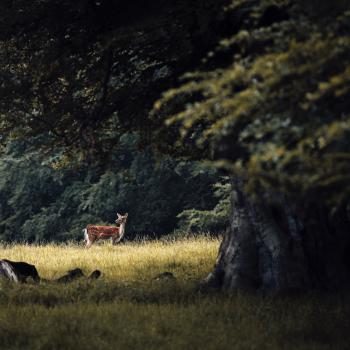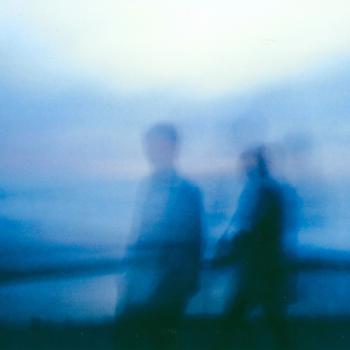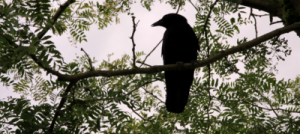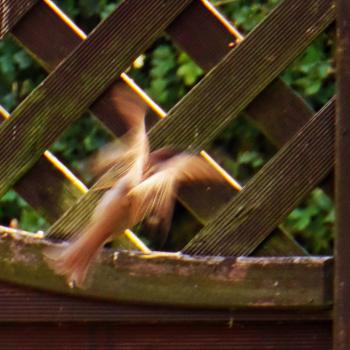 Guest post by Kathleen Housley
Guest post by Kathleen Housley
It is a sunny morning in early June. A sabbath calm suffuses the empty Mt. Holyoke campus, the students having left for the summer. Other than a jogger, I seem to be the only one around, sitting on the stone steps of Pratt Music Hall listening to the sound of a small waterfall flowing into a nearby brook.
I am waiting for an old blue van, edged with rust, to arrive from Wichita, Kansas, over 1,500 miles away. Belonging to Warren Farha, owner of Eighth Day Books, any minute now it will chug up to the curb loaded down with the contents of an entire bookstore for Image’s Glen East Workshop.
Unfortunately, Warren will not be at the wheel this year due to another obligation; instead Joshua Sturgill, his able associate, is making the grueling twenty-four hour odyssey to South Hadley, Massachusetts. Because I live only an hour south in Connecticut, I have volunteered to help him set up the store in one day—a job so large it is on par with Hercules cleaning out the Augean stables.
This area of Massachusetts is often described as Emily Dickinson country. She lived in Amherst eleven miles to the north, attending Mt. Holyoke at the age of sixteen for a single year. One of the reasons she may have left so soon was that all the students were supposed to have a strong faith.
To encourage them (or, to be more truthful, pressure them), the students were categorized into three groups: those who professed, those who hoped to profess, and those who were without hope. Dickinson was in the “without hope” group, even though she wrote to a friend that she was “not entirely thoughtless on so important & serious a subject.”
Despite her reservations about Mt. Holyoke and faith, I think Emily would have liked to be here today surrounded by such a great variety of books that both believers and nonbelievers should be able to find something appealing.
What Emily would not have liked is that there will be no time to read a single book; there will not even be time to skim. There will only be time to unpack, alphabetize, and arrange.
Now Joshua has arrived and we begin hauling boxes up to the Warbeke Room on the third floor. A beautiful performance space with a grand piano and busts of famous composers, the room has a high ceiling buttressed with dark beams. Oriental rugs cover the floor. A fireplace is surrounded by tall bookcases with glass doors.
Over the fireplace is a portrait of a gray-haired woman, wearing a light-blue Chinese dress, against a misty Chinese background. The metal plate on the frame identifies her as Norah Warbeke. Was she a missionary to China prior to marrying John Warbeke, a professor of philosophy at Mt. Holyoke seventy years ago? There is no way, nor time, for me to find out. All I know is that she will glance at me many times today, especially when I arrange books on her mantle.
At ten o’clock, Marilyn de Kleer shows up. Marilyn flew in from California last night to attend Glen East. Now, out of the goodness of her heart, she has come to help. The air conditioner is not on and the atmosphere in the room is heavy and stale. I open the windows to let in fresh air, and we begin.
I start by arranging the art books on top of the bookcases. Because they come in all shapes and sizes, they don’t line up neatly. Furthermore, their beautiful covers demand to be seen, so it takes time to arrange them properly. Then I move to the children’s books, spreading them out on the red velvet bench that stretches the length of the room beneath the windows. Like the art books, they are a riot of color in which Curious George nudges the Hobbit while Babar adjusts his crown.
Marilyn is arranging poetry and essays. She asks which category is appropriate for Elizabeth Bishop’s prose. We discuss it briefly and decide that poets will be most interested in the book, so the poetry category is best. All day long, our conversations will be similar: brief and focused.
Next, I start on the category entitled C. S. Lewis and Friends. I ask Joshua why books by Dorothy Sayers are here and learn from him that she knew Lewis well. But there is a problem: intermixed with Dorothy’s books are those of the American writer Valerie Sayers. I separate those out for placement on the fiction table.
Yet another friend is J. R. R. Tolkien, no problem there. But what about the children’s stories of George MacDonald? Again Joshua enlightens me, telling me about his influence on Lewis. I remember reading At the Back of the North Wind when I was a child, so I can understand Lewis’s enchantment.
And so we continue to work through the day until the last book is set in place. It is time for Glen East to begin and my part to end. I say goodbye and head home, tired, and a little bruised from tripping over a box.
I recall that just before I came, a man had expressed surprise that I would waste my time on such a project. I wish he had been with me today, immersed in the physicality of three-dimensional books, some written thousands of years ago, some in the past twelve months, encapsulating within their covers all manner of mind and spirit.
Or, as Emily Dickinson would phrase it, these frigates, these chariots, bearing a human soul.
Kathleen L. Housley’s most recent book of poetry is Epiphanies (2012) from Wising Up Press.











